
|
|

|
|
Peridot
August Birthstone

I was so excited about peridot that I painted my toe nails peridot! LOL!
|
|
Scientific:
The name olivine is from the Latin oliva in reference to the mineral's color. Peridot is from a thirteenth century English word peridote. Peridot (pronounced pear-uh-doe) is the gem variety of olivine. The olivine's are isomorphous (al����������l have the same crystal structure), with varying chemical compositions. Olivine, which is actually not an official mineral, is composed of two minerals: fayalite and forsterite. Fayalite is the iron rich member with a pure formula of Fe2SiO4. Forsterite is the magnesium rich member with a pure formula of Mg2SiO4. Olivine's formula is written as (Mg, Fe)2SiO4 to show the substitution of the magnesium and iron. Peridot is usually closer to forsterite than fayalite in composition although iron is the coloring agent for peridot.
The green color of peridot, the gem variety of olivine, is mainly dependent on the amount of ferrous iron present, this color then being modified by trace amounts of Fe3+, Ti4+ and Ni2+. The better green colors occur with a Fe:Mg ratio of about 1:8. Higher concentrations of Fe result in less desirable yellow-green or brownish green shades. Pure brown peridots are more rare. Peridot gems have a hardness of about 6.5, which makes them very suitable for use as gemstones in earrings, brooches and pendants. Their use as ring stones requires some extra care to prevent abrasion and loss of polish. |
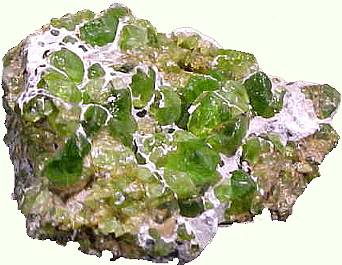
This peridot specimen has a matrix of white clay mixed with in with massive
peridot. This specimen was discovered in 1997 at the Datso Mine in Pakistan.
|
|
Gem quality peridot comes from the ancient source of Zagbargad (Zebirget) Island in the Red Sea off the coast of Egypt; Mogok, Myanmar (formerly known as Burma); Kohistan, Pakistan; Minas Gerais, Brazil; Eifel, Germany; Chihuahua, Mexico; Ethiopia; Australia; Peridot Mesa, San Carlos Apache Reservation, Gila County, Arizona and Salt Lake Crater, Oahu, Hawaii, USA. The best quality peridot has historically come either from Myanmar or Egypt. But new sources in Pakistan are challenging that claim with some exceptional specimens. The Arizona gem material is of lesser quality, but is far more abundant and is therefore much more affordable. An estimated 80 - 95% of all world production of peridot comes from Arizona. The Myanmar, Pakistani and Egyptian gems are rarer and of better quality and thus quite valuable approaching the per carat values of top gemstones. Possibly the most unusual peridot is that which comes from iron-nickel meteorites called pallasites. Some are actually facetted and set in jewelry.
The stone ranges in color from light yellow-green to the intense bright green of new grass to olive. Because of the way peridot splits and bends the rays of light passing through it, it has a velvety, "sleepy" appearance-a shining rich glow. Throughout time, peridot has been confused with many other gemstones, even emerald. Many "emeralds" of royal treasures have turned out to be peridots! And although peridot is distinctly a different shade of green, many jewelers refer to peridot as "evening emerald". Emerald is a dark green as opposed to a yellow green and always contains inclusions. Other green gemstones confused with peridot include apatite (which is much softer); green garnets (have no double refraction), green tourmaline and green sinhalite (both of which are strongly pleochroic), moldavites (no double refraction) and green zircon (significantly heavier). All of these gemstones rarely have as nice a yellow component to their green color as does most peridot, but darker green peridot can be confusing when good crystal form is not discernible.
|
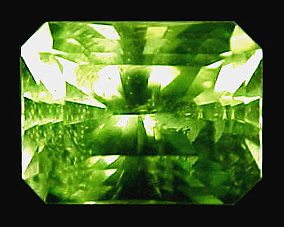
This beautifully fashioned "modified Emerald Cut"
is faceted from a rare piece of Norwegian peridot. The stone contains some small inclusions just visible upon very close inspection.
|
Possibly the most unusual peridot is that which comes from meteorites called pallasites. Some have even been facetted and set in jewelry, the only extraterrestrial gemstones known to man.
Peridot is occasionally treated with colorless oil, wax, natural and synthetic unhardened resins into voids to improve appearance. Surface fractures are sometimes filled with a colorless hardened substance.
Due to its relative softness, peridot jewelry should get special care and handling. Peridot is susceptible to attack by acids, particularly hyrdochloric and sulphuric acids that are commonly found at the jeweler's bench. These acids will remove a stone's polish surprisingly fast. Quick temperature changes should be avoided. |
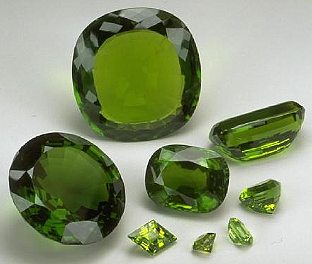
Forsterite (variety peridot) from the
Smithsonian Institute © Chip Clark, Smithsonian National Museum of
Natural History
|
|
As a gemstone, clarity is very important with
peridot. Tiny inclusions that are not singly visible to the unaided eye can nonetheless in quantity impart a "sleepy" or hazy quality to the stone, and make the color, however slightly, more brownish (not desirable).
Peridot is used as a gemstone. Mg-rich olivine is used in refractory sand and brick in the casting industry because of its high melting point.
Peridot is not in such demand that imitators are rampant. However, practically any transparent green material, natural or manmade, could imitate
peridot. Even until recently have jewelers used the term
"chrysolite" (latin for golden stone) in refering to peridot gems for some reason.
Variety of: Olivine
Chemical Composition: (MgFe)2SiO4
Hardness: 6.5 - 7 hardness increases with magnesium content |
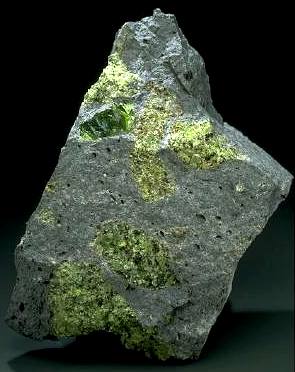
Forsterite (variety peridot) from the
Smithsonian Institute © Charles Vega, Smithsonian National Museum of
Natural History
|
History:
Peridot has been mined as a gemstone for an estimated four thousand years or better, and is mentioned in the Bible under the Hebrew name of pitdah.
Archaeologists have found valuable peridots in Alexandria, Egypt, which must have come from the original source, the island of Zebargad (zebargad being the Arabic word for peridot). It is located about 50 miles from the coast of Egypt in the Red Sea. Faceted stones have also been found in the ruins of ancient Greece and attributed to the same source.
Zebargad, which was known for many years as Saint John's Island, may have been mined as early as 1500 BC The island was discussed in the natural history of Pliny the Elder (23-79 A.D.) as having been explored in the fourth century BC it was called "the Serpent Isle' " since its many poisonous snakes interfered with mining activity. Eventually, an Egyptian ruler had the snakes killed and kept the miners isolated at work on the island. Because the rich green stones were so coveted, guards of the deposits were told to kill any unauthorized travelers approaching the island.
The Greeks and Romans referred to peridot as topazion and topazius respectively and this name was later given to topaz, to end the confusion with the two gems.
Peridot was quite popular during the baroque era. It was originally introduced to Europe by the Crusaders during the Middle Ages, and was used for ecclesiastical purposes. |
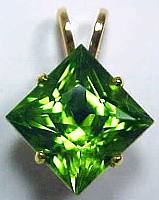
The beautiful peridot gemstone in this pendant was faceted from natural peridot rough mined on the San Carlos Indian Reservation in Arizona, USA.
|
The largest known faceted peridot (310 carats) is displayed at the Smithsonian Institution, Washington, D.C. Now a part of the Diamond Treasury in Moscow, Russia, is a yellowish-green 192.75-carat stone that belonged to the czars. A step-cut peridot of 146 carats is in the Geological Museum, London, England. The collections of the American Museum of Natural History in New York and the Chicago Museum of Natural History have included beautiful examples of
peridot. Many peridots were taken to Europe by crusaders returning from the East and kept in cathedrals. Especially fine specimens are in the Cathedral in Cologne.
Peridot was positively identified on comet Hale-Bopp.
Lore:
Some think that the "emeralds" worn by Cleopatra were actually peridot. Similarly, a large stone at the shrine of the Three Holy Kings at Cologne was thought to be an emerald until correctly identified as a peridot in the late 1800s.
Ancient Egyptians called peridot "the gem of the sun," although they believed its seekers might not find it in sunlight. Because of their brightness in the desert sun, the stones were supposedly invisible by daylight. In darkness, however, they were alleged to give off a light of their own. By night, miners were said to mark their locations accordingly and return to recover their treasures by day. |
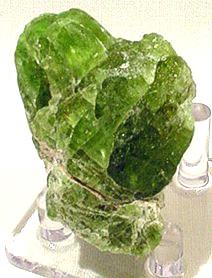
Photo courtesy of Dave's
Down To Earth Rock Shop
|
Peridot was believed to have the power to dissolve enchantments. Pirate's believed peridot had the power to drive away evil spirits (and the night's terrors), especially if set in gold. But as protection from evil spirits it must be pierced, strung on donkey hair and worn on the left arm.
As a medical remedy, it was powdered to cure asthma. Holding a peridot under the tongue was supposed to lessen the thirst of a person suffering from fever.
The high priest's breastplate, which is described in the Biblical book of Exodus, includes a stone for each of the twelve tribes of Israel, one being peridot. The Bible also tells of a jewel worn by King Esekiel from Exodus, an impressive peridot.
Hawaiian natives believe peridot is the goddess Pele's tears. The Ottoman Sultans who gathered the largest collection during their 600-year reign from 1300-1918, with an impressive array of both loose gem stones as well as peridot earrings, peridot rings and other peridot jewelry. |
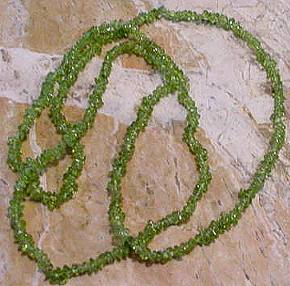
Chipped bead necklace courtesy of a
Private Collector
|
Metaphysical:
Peridot is said to bring healing and vitality to the whole body. It is also said to increase patience, confidence and assertiveness.
Peridot is said to help slow the aging process, physically and mentally. It is also said to be helpful in facilitating the birthing process.
Peridot helps stimulate growth. The brighter, and more yellow the color, the more intense the experience. This is the stone of adventure. We never know what we will find, but it sure is a heck of a ride!
If you want to start a growth period, meditate with peridot in your left hand (the receiving one). Visualize the bright color (and the energy that accompanies it) coursing through your chakras, clearing and grounding them. Then see it clearing and grounding your aura. Tell the universe that you are ready for growth, and trust the universe to do the rest. It's ok to then visualize your chakras returning to their normal colors, it is just more intense this way! |
|











